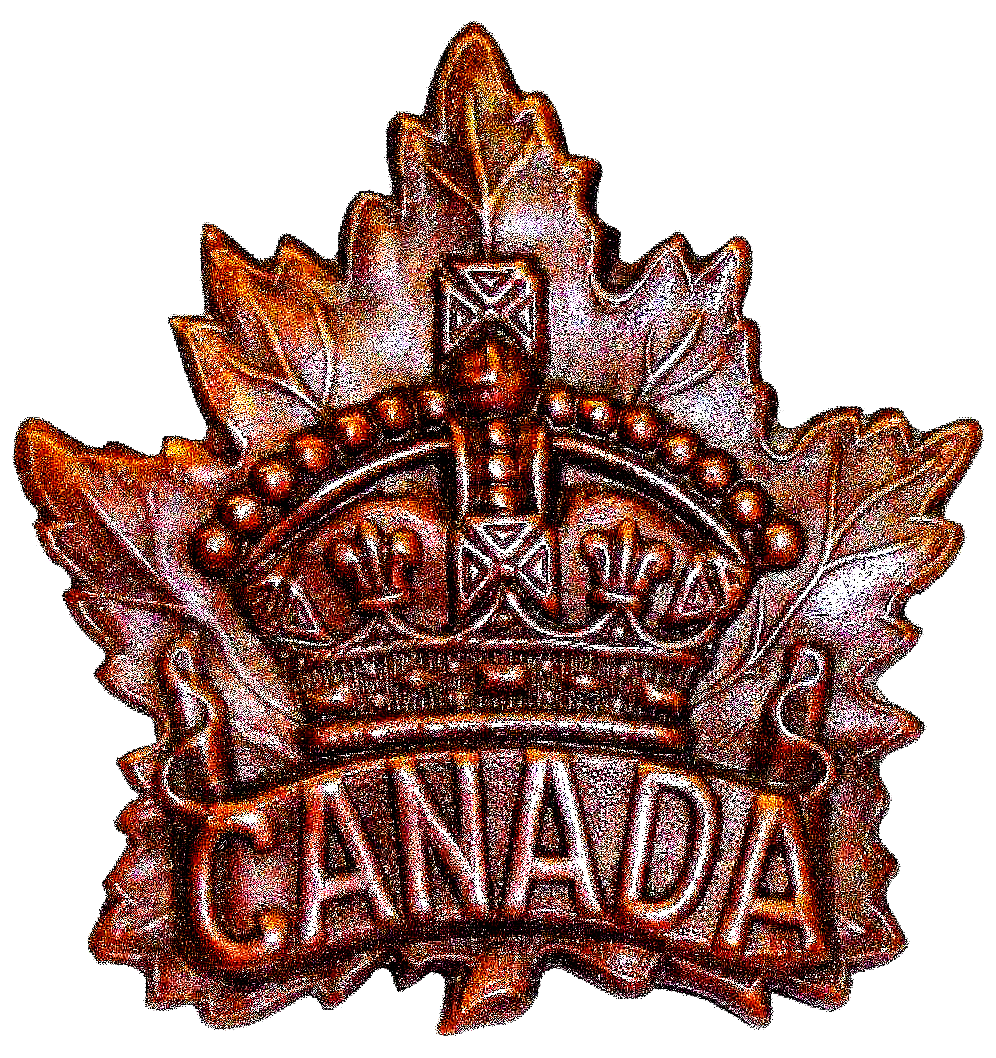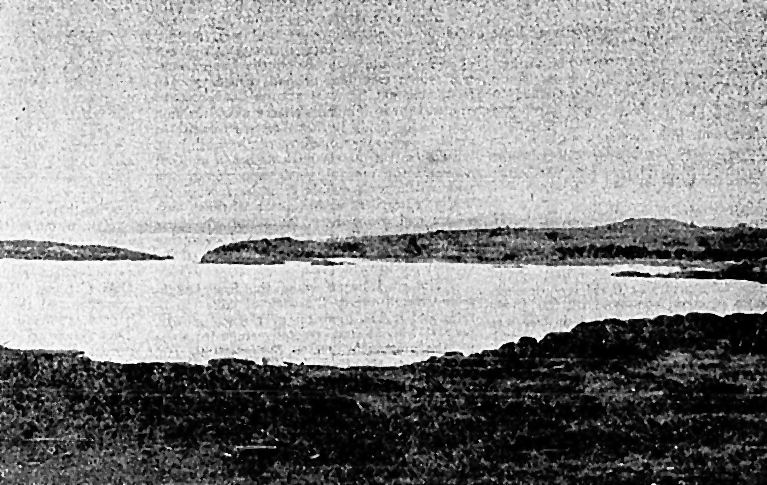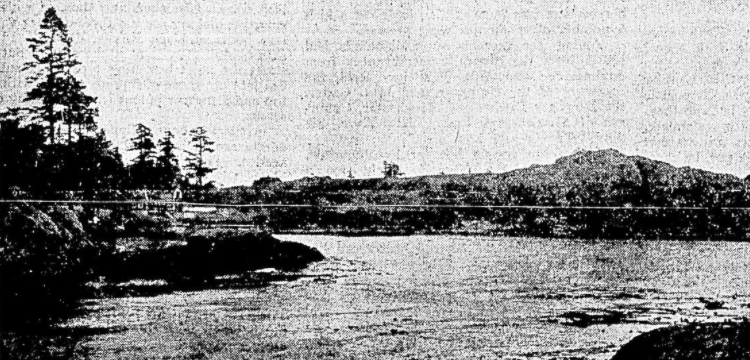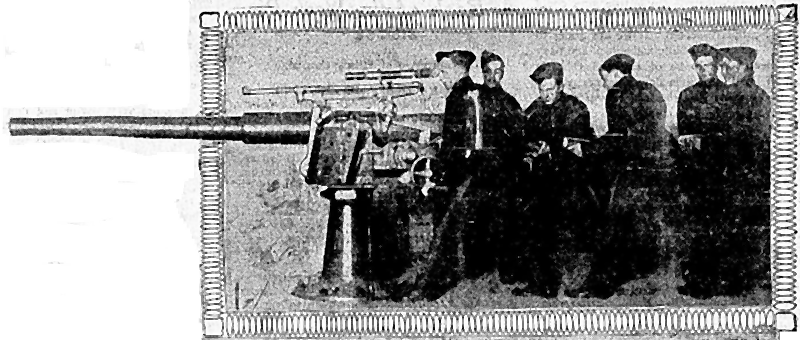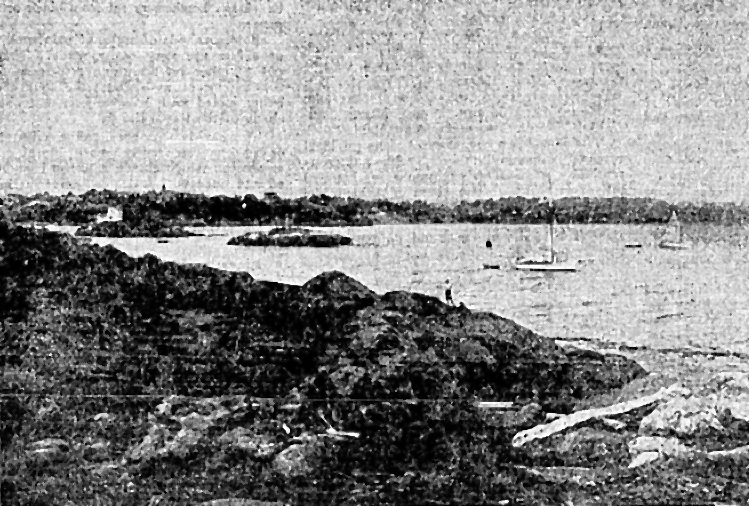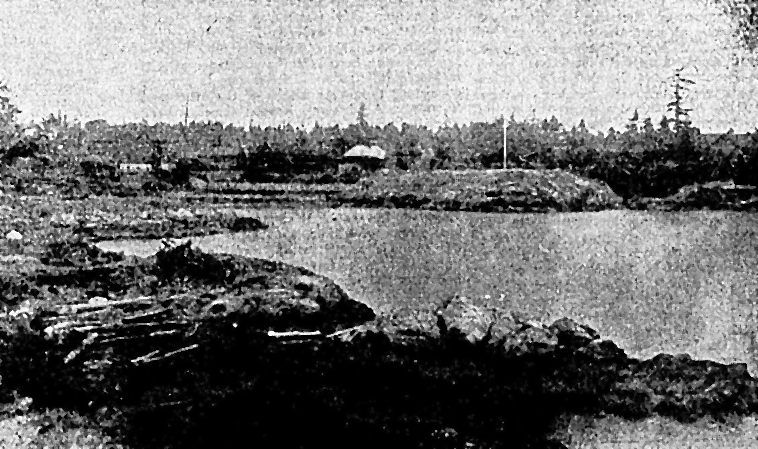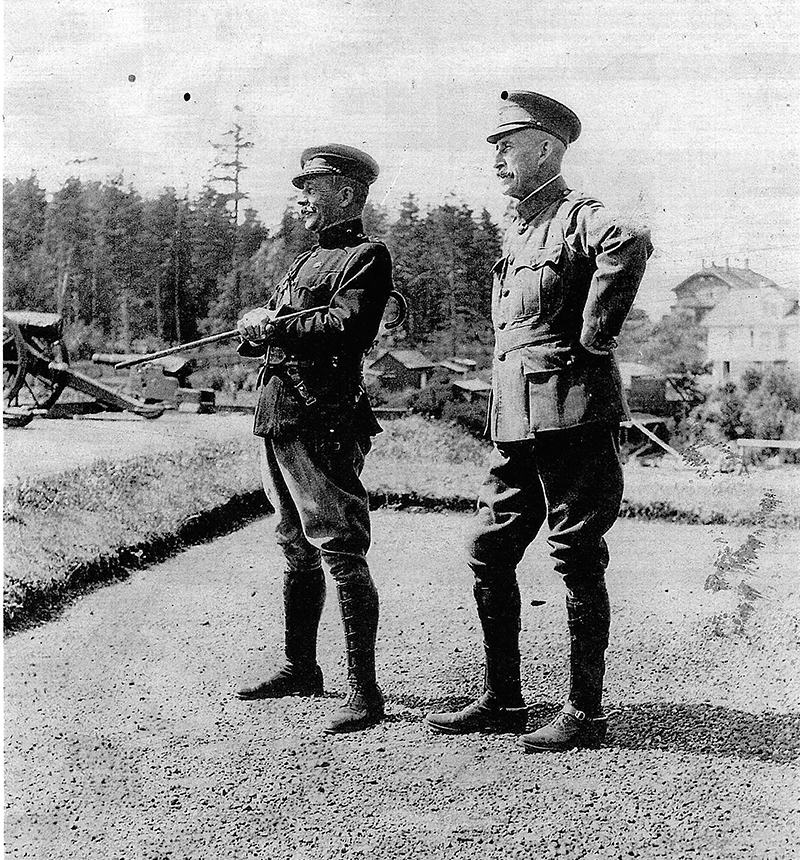 |
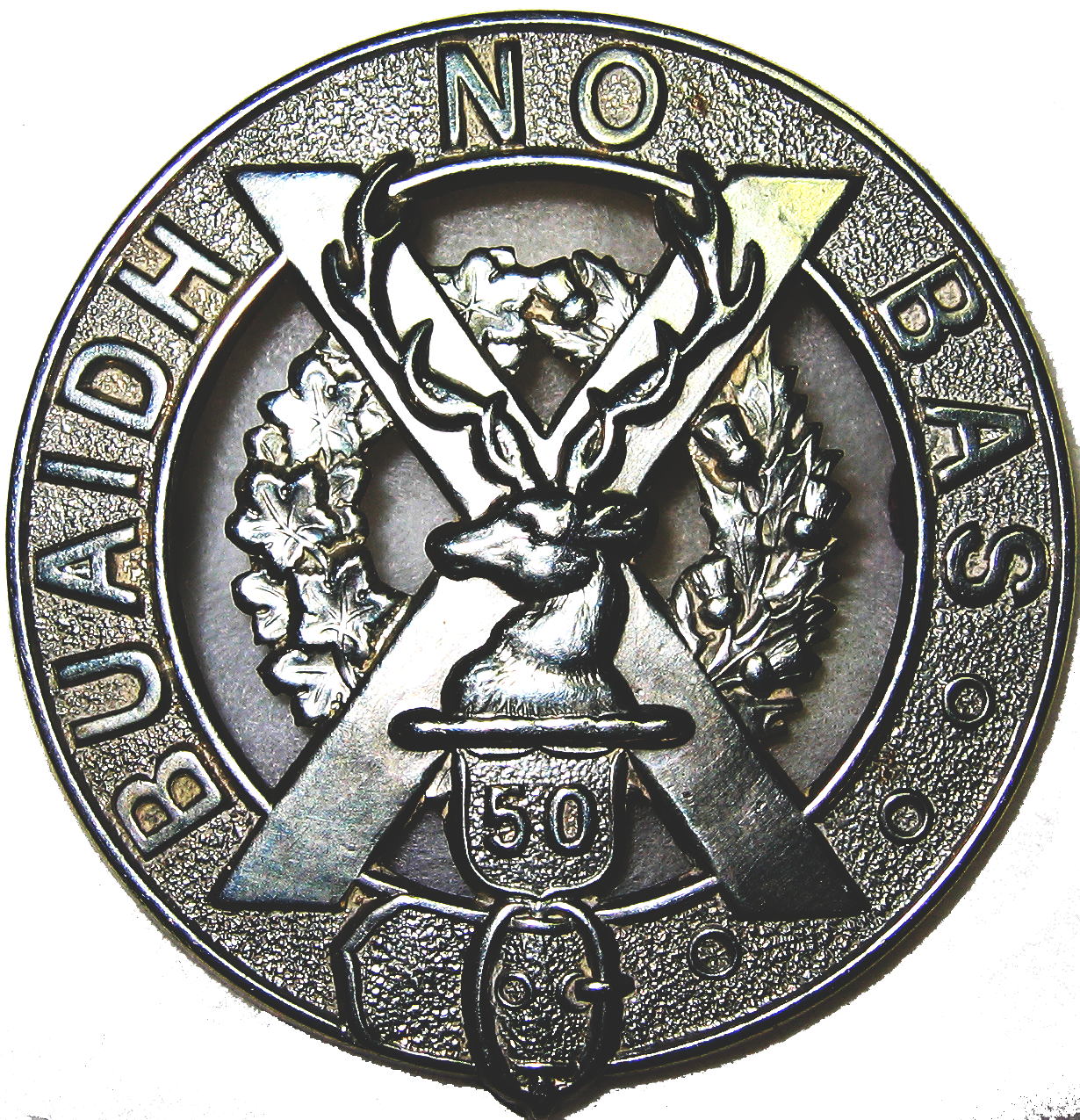 OPCMHVisitor No.: |
HISTORY OF WORK POINT BARRACKSby Jack BatesPART 4 — 1907 to 19181909Daily Colonist LOCAL FORCES SAVE ESQUIMALT Attacking Enemy are Repelled in Well Planned Mimic Warfare The battle of Esquimalt was fought last night and the invaders who sought to force their way, under cover of night, into the harbor, where the British North Pacific Squadron which had taken refuge because if its inferiority was lying at anchor, were repelled. The Esquimalt defences were manned by No. 5 Company of the R.C.G.A. from the garrison at Work Point under command of Major A.W. Currie. The Rodd Hill works were occupied by the gunners of the permanent force who manned the Rodd Hill battery and the anti-torpedo guns of Belmont Battery where Capt. Macdonald and Lieut. Cockburn were in charge, while Black Rock and Duntze Head Batteries were manned by gunners of the Fifth regiment C.G.A. under command of Capt. R. Angus. The tocsin of war was sounded at 7 p.m. The intelligence officers had received word that a state of war existed. There had been diplomatic tension between Great Britain and a certain power – the censor refused to permit the name of the power to be mentioned – and before the wires and communications to the west coast Vancouver Island were disrupted news was sent that a large vessel, apparently the parent ship of a submarine flotilla was approaching the straits. A port war station was promptly made at William Head and watch was maintained. From the night a British warship – the launch Beryl took the part of the warship – came hurrying to the shelter of the land works. The signaling position where it was proposed six years ago to establish a battery of 9.2 guns and where the Imperial troops hid as she appeared, stating that no other vessels had been seen in the straits. On top of Signal Hill – the commanding position where it was proposed six years ago to establish a battery of 9.2 guns and where the Imperial troops erected part of the mounts before they were withdrawn leaving the guns lying at the roadside where they have remained for for six years – the fire commander took up his position, and an hour after nightfall a rocket fired from this position which caused the battery commanders to peer anxiously into the darkness. From Belmont, at the further entrance to Esquimalt harbor, a great beam of light burst out – the searchlight was vacillating, its great pencil of light throwing a lane of brilliancy over the waters. Above it, from the gloom beyond where the red sector of the Esquimalt lighthouse showed, a signal lantern twinkled and then vanished. It shone again, twinkled a few times, and all was dark again. Farthr down the straits the occulting light at race Rocks twinkled regularly, the rest was darkness occasionally lit by the searchlight’s ray. Enemy Sighted From the darkness came a launch. Suddenly the beam of light from Belmont flared on it and it stood out as under a spot light. “A group, commence firing.” Quickly the 12 pounders of Black Rock barked one after the other. Two rounds were fired by them and then two more by the Belmont Battery, and figuratively the launch was sunk. “District intelligence officer reports that Halifax has been attacked,” twinkled the signal lamps. The war was on in earnest it seemed. The sentries peered anxiously over the face of the waters, scanning the horizon to watch for the invading craft. Then came bad news. The signalers read the twinkling lamps. “The enemy has landed at Sooke and are burning homesteads. The Rifle Association has been beaten back.” “There she is,” suddenly shouted the sentry. From the darkness a vessel was approaching. She had two lamps, one above the other, though. It was the incoming British warship, and, as she geared port, flying the signals indicating her friendly character, she signaled that no other vessels had been sighted in the straits. Attack Repelled Meanwhile the gun crews were on the qui vive, waiting. Soon there was work for them. The invading vessel came from the night and as soon as she was deeried gun after gun opened fire. The vessel, making her way toward the entrance to Esquimalt harbor in a dash past the forts, must have been riddled. She could never have lived. Suddenly she swerved and ran – the attack had been repelled. But this was not the end. She was to make another effort. Far from the harbor though, the searchlights picked her up and the guns opened on her. Gun after gun belched blank ammunition as the searchlights made the target plain, a luminous craft bathed in light. Again the attack failed. The invading warship was sunk – and then she returned to her anchorage inside the harbor having been ordered back by the signallers who told the crew of the Beryl that the cruel war was over. They swore the gunners had not hit the launch because they found no marks on her; but the gunners had a very different tale to tell. The manoeuvres were splendidly carried out and the manner in which the communications worked was excellent. February 26, 1909 PAARDEBERG DAY BANQUET AND PARADE British Campaigners’ Association Will Hold Dinner Tonight Arrangements for the Paardeberg Day festivities are complete. Tonight the members of the British Campaigners Association will assemble at Work Point Barracks to hold their annual dinner, for which energetic committees have been preparing for the past several weeks. The toast list provides for a number of addresses which are likely to be exceedingly interesting. On Sunday morning there will be a monster church parade, in which will participate the regulars of the Army and Navy, the British Campaigners’ Association and with them all veterans who do not happen to belong to that body and the band of the Fifth regiment. The latter organization will meet the forces from Esquimalt at the corner of Yates and Government streets. From that point they will march to the Drill Hall, there joining the three local militia companies and the cadet corps. After all have been mssed services will be conducted by His Lordship Bishop Perrin. It might be well to explain in this connection that there appears to be some misapprehension among members of the Campaigners Association as to the arrangement for the Paardeberg banquet. Some are of the opinion that the affair is to take place under the auspices of the Officer’s Mess of Work Point barracks on Monday night. This is not the case, the dinner, as stated, being called for this evening. April 4, 1909 RIFLE CLUB BEGINS SEASON’S RANGE WORK Wind and Cold Weather Mar Initial Shoot But Successful Summer is Expected The Fifth Regiment Rifle Association commenced the season at Crown Point yesterday afternoon. A strong southwest wind was blowing and interfered considerably with the scoring. It was also rather too cold to be as enjoyable as could be desired. There was a good attendance for the opening day, forty members taking part. There will be a shoot on Good Friday morning commencing at 9 o’clock. Eight targets will be in use, so that those who wish may get away early. Major Currie will be the range officer that day. The question of this day is “where was Crown Point” ? April 6, 1909 A Narrow Escape Fred Archer, a three year old boy, had a narrow escape from being drowned near the boathouse at the Work Point barracks yesterday afternoon. But for the bravery of Corpl. Grey, of the R.C.G.A., who happened to go to the scene when the little fellow fell into the deep water, and quickly plunged in and brought the child to land, the little fellow would have lost his life. The boy was playing with the two sons of Capt. Hughes at the boathouse when he fell into the water. April 16, 1909 Street Fighting James Morgan and Dan Robinson pleaded guilty to fighting in the ploice court yesterday morning. They were fined $5 apiece. H.E. Cobb, a soldier from Work Point barracks, was charged assaulting Sergeant Redgrave while in execution of his duty. Fred Peters, K.C., was instructed by the man’s commanding officer, and the case was remanded for a day in order that he might familiarize himself with the facts of the case. Cobb was not detained in jail as Mr. Peters announced that his officer would see that he appeared for trial. April 23, 1909 WORK POINT FORCE WILL BE INCREASED Draft of Men to Augment Present Lot – New Battery Coming Soon From 20 to 30 new men for the Work Point barracks are to be recruited in the west by way of a draft according to a definite announcement made yesterday. The present establishment of 150 men is insufficient to man the defences at Esquimalt and the decision to draft more was taken by the Dominion Government on application from the authorities here. Another noteworthy bit of military news is that the new field battery of six pieces of modern armament for the Fifth Regiment will be on hand in time for the annual camp at Macaulay Point. The battery is now being tested by experts in the east and, will be shipped here directly, the tests are completed. In fact they turned out to be well worn out 12 pound field guns used in the Boer War by the British ... See “Obsolete Field Guns Discussed” January 25, 1910. May 8, 1909 Kingston Military Exams The examinations for candidates for the Royal Military College will be held at the garrison school, Work Point barracks, Tuesday, May 11. The following candidates have presented themselves: A.B. Boggs, C.B. Latimer, O.J.H. Wilkie, T.A.H. Taylor and J.H. Robins. May 14, 1909 Col. Holmes and the officers of Work Point barracks have issued invitations for an “at home” at the barracks for Friday, May 14. May 18, 1909 LETTERS TO THE EDITOR Head Street Slum Sir: It was gratifying to a Victorian to watch, Japanese visitors upon their way down Head street to the barracks this afternoon. They could see white children playing in the green slime of open drains; they could sniff, themselves, odors smelt before in Chinese ports. They could admire the stern economy that fills in hollows on a public road with refuse heaps – heaps piled in front of cottages where typhoid has occurred some months ago. Such sights and smells would ease their Japanese astonishment that the rate per thousand people, of typhoid in B.C., should be some twenty times the rate in England. M. ALLERDALE GRAINGER June 8, 1909 MEMBER BACK FROM OTTAWA A pertinent item reported on: Incidentally Mr. Barnard referred to the little tilt he had had with Sir Frederick Borden with regard to the local defences. It had been closed by the admission by the minister of militia that the Dominion government was content with a garrison at Work Point barracks of less than half the number considered necessary by the Imperial authorities. Colonist TEES WITHIN RANGE OF GUNS Firing From Point Macauley Perturbs Passengers Aboard C.P.R. Steamer Thinking they were being bombarded by the batteries at the Fifth Regiment encampment at Point Macauley, the passengers aboard the steamer Tees which arrived here on Friday night, had a thrilling experience after rounding Brotchie Ledge near the harbour. When the steamer swung in view of the encampment, she noticed ahead a floating target towed by a tug. The tug was proceeding at eight knots an hour, and the Tees was making about the same way. The shells from the one inch ammunition kept whistling right across her course and a number of passengers aboard were in trepidation best one of them should strike the vessel. The Tees had come within one hundred yards of range before the order “cease fire” was given to Number B battery at the encampment. The Tees which was about to reverse her engines was able to proceed on her way to the harbour. June 24, 1909 BADLY INJURED BY EXPLODING SHELL Staff Sergeant Wilkinson, of Work Point Barracks, Meets Unfortunate Accident Struck by the fragments of a twelve pound shell which exploded while he was examining it, Staff Sergeant Wilkinson, of the ordnance department, Work Point Barracks was seriously injured yesterday at noon. With Captain Gillen, the newly appointed ordnance officer, Wilkinson was examining the stores of ammunition in the ordnance shed at the fort on Signal Hill. In some manner the detonator of the shell went off exploding the shell, dangerously wounding the sergeant and slightly injuring Captain Gillen. The entire side of the shed was blown out by the fragments of the bursting missile. Dr. Hart, the medical officer attached to the barracks was summoned, and he hastened to the scene in his automobile. He at once conveyed Wilkinson to the barracks hospital, after attending to his injuries, and it is stated that the unfortunate man will probably recover. Just the reason why the shell exploded is unknown, but it is thought to have been in some way defective, with the result that even in the careful handling given it by the trained man, it was set off. Captain Gillen’s injuries are slight. Wilkinson had been attached to the barracks for many years, having been drafted out here with the Imperial troops. His time expires at the end of this week, and he with his wife and son was to leave on his return to England on Tuesday next. He is extremely popular with his comrades at the garrison – and the news of the accident aroused consternation. The fort at Signal Hill lies at the city side of Esquimalt, and commands the entrance to the harbor. The ordnance shed which serves the battery of guns is situated at this point, and it was while inspecting the supplies of ammunition at this point that the accident occurred. The inspection follows the recent appointment of Captain Gillen to succeed Captain Sullivan, until lately in charge of the ordnance department here, but who has been transferred east. Captain Gillen’s injuries were of the slightest, and his escape was miraculous as the entire side of the shed was blown out. No official statement with regard to the accident could be obtained last night. July 14, 1909 NEWS OF THE CITY Improvements on Head Street Improvements are being made on Head street. The bridge at the end of the street is being replaced by a fill. Meanwhile the main thoroughfare to the barracks is closed. August 10, 1909 INTERESTING SERVICE AT ST. SAVIOUR’S The twenty first anniversary of the founding of St. Saviour’s church, Victoria West, was appropriately celebrated at the dedication festival which was held in that church yesterday. The services were mostly of a festal character – festival exercises and holy communion in the forenoon, matins and holy communion (choral) in the afternoon, and evensong. The choir rendered a musical programme, which was prepared by Miss M.M. Miles, organist of the church. The dedication service sermons were preached by Rev. C.E. Cooper. The Rev. W.W. Bolton founded the mission and held the first Anglican service in Victoria West on August 5, 1888, when he was rector at Esquimalt and the large transept built for the came a great many difficulties in founding this and other missions in those early days. The original place of worship was a lumber room over the carriage and blacksmith shop of Mr. Gerow, and the first mover in the matter was the late Mrs. Burrows. Thanks to the care of Mr. Bolton and of subsequent rectors and parish officials, the early records are intact. Mr. Bolton was succeeded by the Rev. F.L. Stephenson at Easter 1889, and he by the Rev. W.E. Ellison on September 15 of the same year. On the 5th of October, 1890, the Rev. W. Davin Barber was appointed to the charge of the mission, and the next year the church was built and consecrated by Bishop George Hill. Under his rectorship the church was also enlarged and the whole parish was developed. It was with universal regret on the part of all who knew him that Mr. Barber’s health compelled his resignation in 1904. On Thanksgiving Day, November 17 of that year, the church wardens on behalf of the parishioners and friends, presented Mr. Barber with a purse of $ 860, as “a sincere, if inadequate, testimonial of their gratitude and esteem.” Mr. Barber was soon after able to take a chaplaincy at Smyrna, in Asia Minor, then he was appointed a living in Lincolnshire, and about two years ago to a rectory in Hertfordshire, in the neighborhood of his old home, where he now resides. He was succeeded by the Rev. Charles E. Cooper, who, after much experience in English parishes, came to this diocese with Bishop Perrin, and did good work at Wellington and Nanaimo. Mr. Cooper was the preacher yesterday. For many years St. Saviour’s occupied the position of garrison church, and many were attracted to the little church by the presence of the soldiers and the military band. Since the relinquishment of the Work Point Barracks by the Imperial troops and consequent placing of attendance as a purely voluntary basis, interest on the part of the military has ceased. Mr. Bolton met with and overwearers of the King’s colors is used by a small handful. Dave Eastick’s grandfather, Joseph Thomas Eastick, as a member of the Royal Engineers at Work Point, was instrumental in affixing the bell in the church tower. He also had the duty of pumping the bellows for the organ. August 16, 1909 Injured by Fall Through slipping on the stone sidewalk on Wharf street near Fort street early yesterday afternoon, Corporal Whitesides of the Work Point garrison, sustained two gashes on his head besides minor bruises. A cut over the left eye and one on the back of the head necessitated his being hurried in the police patrol wagon to Dr. Hart’s office where the wounds were dressed and the injured man was then conveyed to the barracks in a cab. New Tariff The board of railway commissioners has approved the new parlor car tariff relative to the E. & N., published in the current number of the Canada Gazette. It became effective September 15th, and provides for a fee of twenty five cents a seat for forty miles or less, and twenty five cents per seat for anything between forty and eighty miles. As the whole length of the railway is only eighty miles the maximum charge is fifty cents. August 22, 1909 The Pacific Gateway of Canada The pictures below may in days to come possess an historical interest. Word has gone abroad that the Dominion of Canada proposes to undertake a part, at least, of the naval defence of British interests on the Pacific Ocean, and in all reasonable probability, this will involve the establishment of more extensive defence works, and the maintenance of a stronger garrison at this point than are now in existence. Pictures are almost innumerable of Esquimalt harbor, where the headquarters of the fleet used to be and will, we hope, be again; but the above pictures, taken expressly for this page, are new. They show Work Point and the Officer’s Quarters thereon as well as the saluting battery, which is grouped around the flag staff. They also show the entrance to Victoria harbor by which Work Point is reached from the sea. The waterway lies to the left of the lighthouse, but beyond that point it is only available for shall craft. There is a broad sandy beach at the head of Rose Bay, reached by this channel and the Barrack grounds come down to the shore. The other two views are of Fort Macaulay. They do not look much like pictures of a fort, you will say, and that is true enough, but if you want better ones you will have to get permission of the Militia Department at Ottawa to take them, and there would be very little use in making for that. There are points from which you can see the tops of some low buildings, and there is an exceedingly uninviting fence which bids you defiance, if you feel inclined to trespass. What would happen to you if you did trespass, deponent saith or not, for he has never yet mustered up sufficient courage to try. One day he and some others, one of them occupies one of the seats of the mighty, went over to Rodd Hill, which is another fortification, and with hearts free from guile and reasonably full of patriotism endeavored to land. As soon as the first of them stepped ashore, a young man in khaki approached and made some observations to the effect that the Dominion of Canada, as represented by him, would prefer our room to our company. The man, who occupies one of the seats of the almighty, thereupon ventured to mention who he was; but the man in khaki was not in the least impressed. Indeed he courteously informed us that he did not give a something or other who he was, we had no right there, and he proposed that we should get back into the launch again. There was, however, a genial twinkle in the northwest corner of his eye, and when we assured him that we would certainly obey his behests, but we really wanted to walk around the rocks to the lagoon, he observed that “orders is orders,” thereby violating the rules of Lindley Murray in such case made and provided, and walked away. Well we went around to the Lagoon and it is only right to assume that he did not see us. We did not trespass further upon his attention by coming back again, but sent the launch to another place, and doubtless its ferocious puffing convinced him that we had complied with his directions in spirit at least. This experience was a sufficient deterrent to any attempts at exploring Fort Macaulay with a camera. It is, as the picture shows, a placid looking spot; but if you happen to be out on McLaughlin Point, from which the picture is taken, when the Fifth Regiment is using the big guns, you will see a great black thing emerge from about a third of the distance down the slope; there will be a bright flash; a lot of brownish smoke will arise and then a crash will smite your ears, and if you look out to sea, where the two little flags are being drawn through the water by a tug, steaming at a respectful distance from the line of fire, you will see a great splash, where a shell strikes the water, or perhaps you will see the missile ricochet from the sea like a stone skips when thrown at the right angle, and occasionally you may see the shell burst in the air or throw up a geyser, when it has exploded under water. Then you realize that there is a fort down in the bowels of that hill into the recesses of which the great black gun has dropped after discharging its load. In this innocent looking mound there are three 6 inch guns, which can do effective work at a distance of five or six miles, and could not safely be trifled with even at a greater distance. It is behind the fort that the Fifth Regiment goes into camp every summer.
The view of Macaulay Point from the west suggests something like a fortified place, but really the rocks have nothing whatsoever to do with the fort. The outlook from the top of them is very fine, but as you cannot go astray for fine outlooks around Victoria, there is no special use of saying anything about it. There are two other forts further west, one on each side of the entrance to Esquimalt harbor. Black Rock is on the east and Rodd Hill on the west. There are batteries of 12 pounders here, and they are intended to guard the narrow entrance to the harbor in case of possible raids by torpedo boats or craft of that kind. Between the two forts and covered by the mine field, where in the event of hostilities all sort of submarine defences would be planted.
These things are all very good for war as it used to be, but not very formidable in the case of war brought up to date. A hostile ship could sail up the Strait of Juan de Fuca, lay off shore, and blow Victoria to pieces, if it wanted to, or it could sail up to Vancouver and do all manner of mischief there. A modern warship could lay off English Bay and drop shells into almost any point in Vancouver harbor. If this western outpost of Empire is to be rendered strong, if the western gateway of Canada is to be made secure, there will have to be something much more formidable provided. In the picture of Fort Macaulay from the east there is visible a faint outline of low hills stretching away to the left, and if the picture took in sufficient area and was large enough, it would show the Race light, which marks the pathway of ships from the ocean. The Strait is about nine miles wide at this point, and it keeps that width with fair uniformity for a considerable distance towards the ocean. Out in that vicinity is where a powerful battery should be built so as to command the approach to the harbors within the Race and the waterway to Vancouver. No hostile ship could possibly get past a powerful battery here if it were properly served. If we are going to have a fleet on the Pacific and a dock and a navy yard hereabouts to be of any real value in case of hostilities, it is down on this part of the island coast that the first line of defence must be placed. By treaty between Great Britain and the United States the Strait of Juan de Fuca is territorial water, the former owning the north half of it and the latter the south half. It was the Emperor of Germany who drew the line on the map, when the matter was referred to him by the two powers some years rather more than a quarter of a century ago. A hostile ship would hardly be permitted by the United States to be in its waters and attack a British fort, although if it did so, guns on Vancouver Island could reach it. Therefore an enemy’s ship would have to come within five miles of a battery out near Pedder or Beecher Bay, and the right kind of guns served by the right kind of men would be pretty safe to keep her out. The naval commander who would risk an attempt to get his ship past such a battery would have a good deal of nerve. He would have hardly a gambler’s chance of getting through in safety. For a distance of twenty five miles he would be under the fire of the battery and if he could run a gauntlet like that he would almost deserve to have the cities beyond at its mercy. The present defences are only intended as a protection to the dock and naval yard at Esquimalt, not for that of the cities of Victoria and Vancouver. Neither are they in any sense of the word a protection to the western terminus of the Canadian Pacific Railway nor of the collieries on the east coast of the island. These are absolutely undefended.
As has been shown above, the approach to Esquimalt harbor by a hostile fleet can be made practically impossible from the sea. It is interesting also in this connection to note that at Constance Cove there is a site for a dock, which would be absolutely out of the reach of an enemy’s shells, provided a hostile ship should happen to pass a battery near the Race. The conformation of the ground is such that the surrounding hills, one of which is Signal Hill, on which there is a fort without any guns, the latter resting in innocuous desuetude at the bottom of the hill, protect it. The entrance to Victoria is under the protection of the guns at Fort Macaulay.
September 1, 1909 TAKES COMMAND OF MILITARY DISTRICT Colonel Peters Succeeds Col. Holmes in Charge of Local Post Colonel J. Peters formally took over the command of military district No. 11, including British Columbia and the Yukon, from Col. J.C. Holmes yesterday. He will at once take up his residence at the barracks – vice – Col. Holmes who is retiring. No parade or military display marked the incoming of the new district commander. He arrived at headquarters at 11:30, unattended, and joined Col. Holmes, and his aide de camp, Major C.C. Bennett, by the tall garrison flagstaff, where the incoming and outgoing commandants greeted each other. The party then returned to headquarters and plunged into the mass of documentary detail connected with the district command, spending several hours in the office and then making the round of the post on a tour of inspection. Colonel Peters, the new D.O.C., has been stationed at Esquimalt on two former occasions, being in command of the post about ten years ago. He comes here from London, Ont., where he has been stationed for some years as commander of the district of Western Ontario. “Never was there a more welcome transfer than the one which brings me back to Victoria” said Colonel Peters yesterday, as he looked around the familiar barracks. “Everything here looks familiar and I am more than glad to be back again. It is nearly ten years since I left last time, and I have been looking forward all that time to coming back some day”. Colonel Holmes’ retirement is on account of the age limit. He was entitled to retirement and pension in 1906, but elected to retain his command until he reached the regular age of retirement. “I have been in Victoria on and off since 1883”, said Colonel Holmes, “I am leaving now, but only for a year or two of travel, in this country and abroad. Then I will come back to Victoria and settle here permanently. My present plans are to go with my family to Kingston, Ont., and pass the winter there. I was stationed at Kingston for some time during my early years in the service, and am looking forward to visiting the place again, and spending a winter in the cold climate.”
TIMES NEW D.O.C. IS IN COMMAND COL. HOLMES RETIRES, COL. PETERS SUCCEEDS The formal transfer of the command of the military forces of British Columbia has been made, and Col. J. Peters, the new D.O.C., is in charge of the offices at Work Point Barracks, Col. J.C. Holmes retiring. The selection of a new district commander in the person of Col. Peters will prove a very popular one, as he made a host of friends when stationed at Esquimalt on two former occasions, where he was in command about ten years ago. The new D.O.C. has been for some years in command of the district of Western Ontario, and arrived from London, his former headquarters on Monday evening. Col. Peters expresses himself as delighted to be back amongst his friends in Victoria once again and hopes his stay this time will be a long one. The return of the D.O.C. to his old post is not more agreeable to him than to the people of Victoria and Esquimalt, who remember him, not only as an excellent commanding officer, but as an all-round “good fellow.” Col. Peters is at present a guest at the Oak Bay hotel, and until he has made some necessary arrangements for a residence in Esquimalt district will remain at the beach resort. Col. Holmes, the retiring D.O.C., is an old resident of Victoria, having been here since 1883. The colonel’s retirement is in consequence of his having reached the age limit. He was entitled to retirement and a pension in 1906, but chose to retain command until he had reached the regular age of retirement. Col. Holmes intends leaving for a tour of Europe which will occupy two years, but will return and probably settle in Victoria permanently. The winter will be passed with his family at Kingston, Ontario, where the Colonel was stationed during his early years in the service. Colonist LIEUT. COL. HOLMES We take this opportunity to bid good-bye to Lt. Col. Holmes on behalf of the Colonist and its readers. Col. Holmes has been with us for so many years that most of us had begun to look upon him as a fixture, and although every one knew that, notwithstanding his personal youth, the time would infallibly come when he would have to retire, however we all expected that he would enjoy his otium cum dignitate somewhere within reach of the breezes from the Strait of Juan de Fuca. But it seems he has, temporarily at least, decided to live elsewhere, and we can only say to him and his family that they will be greatly missed, and that we hope they will come back again. Everybody does who can. Just a word as to that excellent soldier, Lt. Col. Peters, who succeeds Lt. Col. Holmes. He is no stranger to Victoria, where he has so many friends. He is welcome back. As we had to have a successor to the retiring D.O.C., we do not know of anyone, whom the people of Victoria would have been as pleased to have, as the new incumbent of the position. September 4, 1909 MAJOR A.W. CURRIE IN COMMAND Col. J.A. Hall Formally Retires From Service With Fifth Major A.W. Currie formally assumed command of the Fith Regiment yesterday morning, the transfer takng place at the drill hall. The ceremony consisted in Lt. Col. J.A. Hall turning over all the stores of the regiment to his successor. Major Currie has been in charge of the Fifth for the last month, Col. Hall having been on leave of absence. He has not, however, taken over charge of the stores, so that before officially assuming his snew post yesterday’s ceremony was necessary. A recommendation has been forwarded to the Militia Department at Ottawa recommending that Major Currie be promoted to a colonelcy. October 17, 1909 MILITARY TOPICS Improving Sound Forts Two heavy dortress guns, weighing 60 tons each, are being landed at Fort Worden to improve the Puget Sound defences. The steamer Rapid Transit of the P.S. Navigation Company took the guns to the fort. The Transit had considerable trouble in loading the heavy pieces of ordnance in order to place them on the beach above high tide a railroad had to be built from the barge on which the guns were loaded to the beach. The building of this road and the landing of the guns required five days time. The big guns will be mounted on the bluff which is about 200 feet above beach where they were landed, and the job of taking them up the steep hill will be an interesting one. This will be done by the engineers. This location is on the point of land at Port Townsend, Washington, within the Fort Worden State Park. The Regimental School of the Fifth Regiment has passed through its first phase, that of infantry drill, and tomorrow night work will be begun on the big guns, a systematic course of instruction with the theory and practice of gunnery being carried out. On Friday night the examination in infantry work took place by Major A.W.Currie and Majors W. Ridgeway Wilson and B. Booth. Major A.W. Currie, speaking of the showing made said: “The examination was very satisfactory, and showed that the members of the class had carefully assimilated the instruction given. They displayed a great deal of enthusiasm and if the same result is obtained in the 12 nights that are to follow before the school comes to an end, it should be a most satisfactory one.” The work that is to follow in the regimental school will be most interesting. Instruction will be given in gun drill on the 12 pounder quick firer and the six inch guns by Serg. Gillen, R.C.A., and lectures will be given by Lieut. Coburn, R.C.A., on the 12 pounder, and by officers of the Fifth Regiment, C.G.A. on the six inch gun. Instruction will be given in the maxim and depression range finder work by Sergt. Major Caven. Considerable enthusiasm has been displayed by members of the Fifth Regiment concerning the formation of the proposed regimental association and a committee has been appointed. Continued ... |
